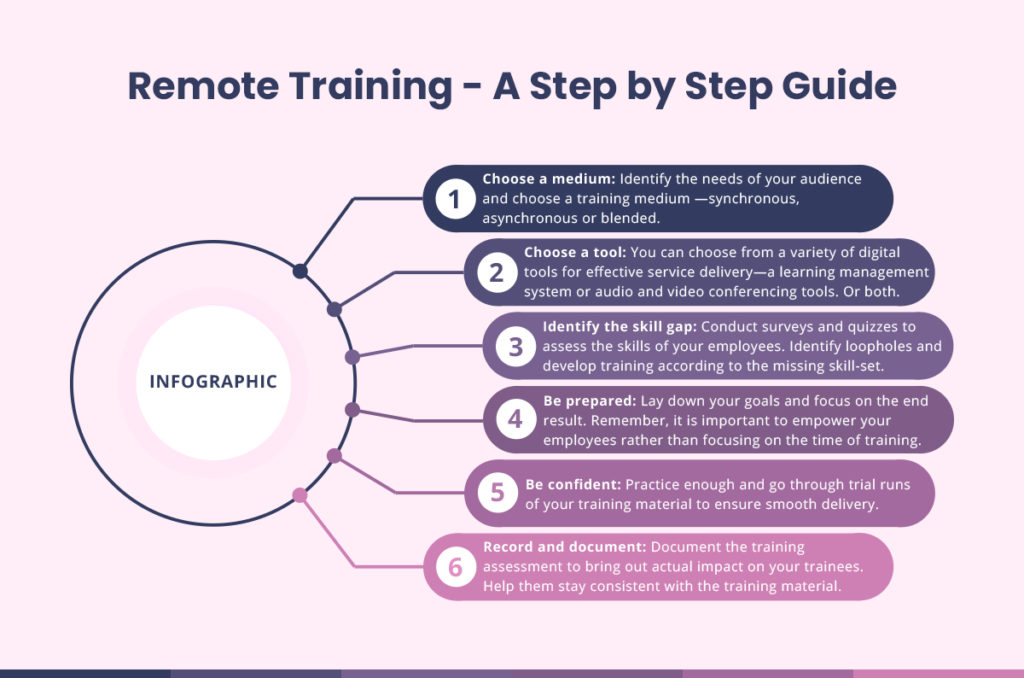An excellent customer service team is what you need to deliver a stellar customer experience.
However, a great team isn’t just built overnight. Dedicated training and onboarding strategies for your employees are crucial for a successful customer service team.
In a remote working environment, it is especially paramount to ensure development and progress to keep employees engaged.
Employee engagement is also the beginning of your customers’ success.
We’ve put together this infographic article to help you understand a step-by-step process of curating an impactful training experience for your existing as well as new employees.
But first, let’s understand why it is difficult for employees to be trained remotely and the general challenges that tag along with remote work culture.
(1) Shorter attention spans:
Generally speaking, we are more productive when supervised or monitored. Working from home might offer flexibility, but it comes at the cost of shorter attention spans. Employees start to feel the need to check their phones or maybe take a longer break without face-to-face supervision, hence, leading to more distractions.
(2) Connectivity issues:
Working from home means shared resources with other family members. Limited bandwidth on broadband connections is a common issue faced by remote workers affecting their productivity to a great extent.
(3) Personal Development:
Along with getting the hang of remote working tools, employees need consistent training programs to stay informed of the latest skills and trends in their respective fields. Remote training and development is a huge challenge for employees who are constantly looking forward to growing with an organisation.
Needless to say, the thought of curating an interactive, user-friendly and impactful training program can seem a bit overwhelming in the beginning. But don’t sweat; follow these simple steps to draft a robust training program for your employees.

(a) Choose a medium
It’s imperative to keep in mind that employees are working from home and that they have a life outside of work. Respecting time boundaries is important when curating any training program. This also trickles down to a productive and effective remote work strategy.
There are primarily three mediums of training delivery—synchronous learning, asynchronous learning and blended learning.
- Synchronous learning: Simultaneous learning via meetings or online sessions is known as synchronous learning and is the most popular medium of training delivery.
- Asynchronous learning: This type of learning is self-paced and involves access to e-learning resources online. It is not time-bound and considers the time boundaries of remote workers as well.
- Blended learning: As the name suggests, this type of learning is a mixture of both to give a custom solution.
(b) Choose your tool
Digitalisation has affected every domain and training is no different. Traditional classroom training is not effective in today’s era of digital learning. A variety of tools are available to deliver impactful training like podcasts or webinars.
Take time to compare these tools and choose the best collaboration tool for your remote team members. Here are a few examples of the tools available:
- Learning management systems
Earlier, these systems were only available to educational institutions for delivering lectures and coursework.
However, companies too have adopted a culture of learning management systems. If you are planning to implement one for your organisation, think about the modules and months your training program will be split into. Do you need to conduct webinars or video training sessions? Decide on the course content and hence, the medium.
- Video training
Learning remains incomplete without face-to-face training. But in the current scenario, the closest we could get to a face-to-face interaction is via video conferencing tools. Technologies like that of cloud telephony offer audio and video conferencing capabilities to train remote employees better.
Trainers can also record their sessions and use them later for those who couldn’t attend the session.
(c) Identify the skills that need to be trained
While preparing to train your employ
ees, you need to be clear about the aspects you want to upskill for your remote employees. It could be as basic as simple excel tricks or as complex as customer service training. This practice is also known as skill gap analysis.
You can work on the same by following simple feedback techniques and gain employee insight into how they spend their work hours. Moreover, employee quizzes and surveys can be conducted to uncover these skill gaps and work towards the same.
(d) Be proactive
Following these simple steps while delivering remote training can be helpful:
- Be clear on your goals―both short term and long term―to stay focused
- Be consistent and impactful with your training schedule. Keep your employees’ time a priority
- Prepare learning material and handouts to make it convenient for your remote team to understand the content better
- Establish ground rules such as being discipline while on call, unmuting the audio to speak or using the ‘raise hand’ feature to ask questions and prevent chaos
- Ensure IT support for a smooth flow of your training session
- Ensure everyone is informed about the time and date of the session
(e) Be confident in your delivery
It is not only essential to curate and develop valuable training content, but it is equally important to deliver one with confidence and impact. Make sure you have had your rounds of trial runs and practice before the final delivery.
This will make sure the training delivery is smooth and confident. Arrange your background to make it a professional experience and a no-distraction zone for your remote employees.
(f) Record and document your training
To assess the efficacy and improve your training structure, you must document and evaluate the result of your training. This can be done by exchanging feedback with the trainees to answer their queries and clarify doubts. Take some time out to interact with the trainees and conduct surveys to improve their learning and your training structure.
Keep in mind to reward and recognise your trainees post-completion. They are more likely to stay consistent with the training sessions when their efforts are appreciated.
Finally, don’t forget to track the results of your employees. As a trainer, you might be interested in the completion of your training. However, it is crucial to focus on the goals rather than time spent. Record assessment scores and results to evaluate trainee performance.
Conclusion
We hope this infographic will help you create an impactful training structure. With remote work becoming the norm, regular training is hard to ignore. Following the above-mentioned steps, you can empower your employees and help them stay engaged with your organisation. Right tools for virtual training can take you a long way.
To know more about them, call us at 1800-120-4132

















